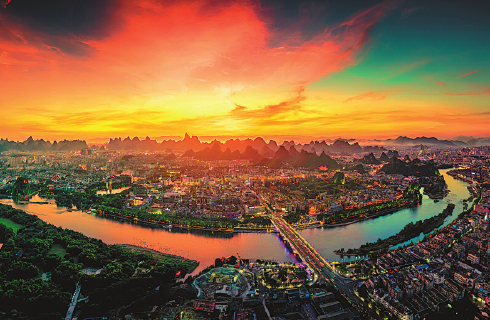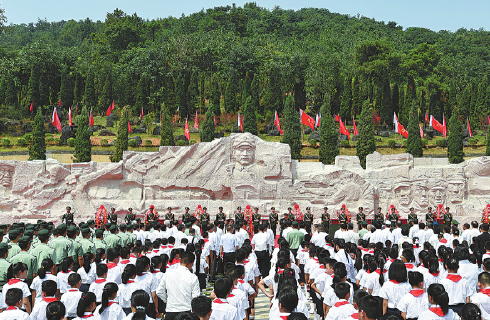Red tourism sites add to region's glow

The sunset in Guilin in Guangxi Zhuang autonomous region. CHINA DAILY
Learning from revolutionary forerunners, Guangxi looks to boost exchanges with ASEAN, RCEP members
Ten Red tourism routes were recently launched in the Guangxi Zhuang autonomous region as part of the celebrations for the 100th anniversary of the founding of the Communist Party of China.
The routes, developed by the region's Department of Culture and Tourism, allow tourists to explore the best of what the region has to offer in the history of Chinese people's fight against the old social structure and foreign aggressions-especially those led by the CPC-before the founding of the People's Republic of China in 1949.
They cover a wide range of areas across Guangxi and take travelers through history spanning from the Taiping Rebellion against the Qing Dynasty (1644-1911) in the 1850s and 1860s, to the New Democratic Revolution that began with the May Fourth Movement on May 4, 1919, the War of Resistance Against Japanese Aggression (1931-45), and the country's reform and opening-up as well as the achievements of modern development.
"Guangxi is an important birthplace and inheritor of our Party's revolutionary spirit," said Lu Xinshe, Party secretary of the autonomous region.
A large number of revolutionary forerunners, including Deng Xiaoping, Wei Baqun and Li Mingrui, fought hard for national liberation and people's happiness in historical events such as the Baise, Longzhou and Xiangjiang uprisings, Lu said.
By 2020, Guangxi had more than 20 national Red tourism sites that are rated 3A or above, and eight have been named national models for patriotic education, according to the local government.

The memorial park dedicated to the Battle of the Xiangjiang River during the Long March in the 1930s. CHINA DAILY
The authority has integrated Red tourism sites with neighboring resorts and developed arrangements for travelers with a schedule of one to three days to follow the footprints of those revolutionaries.
"Their revolutionary and fighting spirit has inspired the Zhuang people-one of the region's ethnic groups-to unite and work hard, and promoted the historical achievement of enriching people's lives and Guangxi's prosperity," Lu said.
In the following tests of reform and development, poverty alleviation and epidemic prevention and control, a group of model workers have emerged and dedicated themselves to the final success, he added.
The late Baini village official, Huang Wenxiu, who died in a flash flood at the age of 30 on June 17, 2019, had committed her life to poverty alleviation.
Since March 2018, Huang had led poverty alleviation efforts in the village. A total of 418 villagers were lifted out of poverty thanks to her efforts.
She was named "a role model of the times" by the central government.
Locals like Huang have continued to make breakthroughs in Guangxi.
"We will implement the 14th Five-Year Plan (2021-25) and focus on the theme of high-quality development," said Lu.
The region will fully tap into its geological advantage for opening-up by linking 11 countries and boosting exchanges, and upgrading major cooperation platforms including the China-ASEAN Expo and China-ASEAN Business and Investment Summit.
The goal is to "create a market-oriented, law-based international business environment, and constantly improve the development level of an open economy", Lu said.
The region borders ASEAN member nations on land and sea, and has the potential to offer the shortest travel time, best service and cheapest price between China and ASEAN nations.
Last year marked the 10th anniversary of the establishment of the China-ASEAN Free Trade Zone.
The 17th China-ASEAN Expo held in Guangxi's capital Nanning last year increased its service coverage to the 15 participating countries of the Regional Comprehensive Economic Partnership.
The RCEP agreement was formally signed on Nov 15, launching the world's biggest free trade bloc. The 10-member ASEAN and its five free-trade partners-China, Japan, South Korea, Australia and New Zealand-inked the agreement via video call, in which all pledged to lower trade barriers and promote interregional relationships.
Over the past 17 years, the China-ASEAN Expo has not only demonstrated extraordinary achievements in deepening trade and investment cooperation, but has also fostered cultural exchange and mutual understanding, said Virasac Somphong, consul-general of Laos. It improves people-to-people exchanges between ASEAN nations and China as well as between Laos and China, Somphong said.
The 15 participating countries of the RCEP account for about 30 percent of the global population, global GDP and global trade.
In 2020, the number of rail trips originating or terminating at Beibu Gulf ports in Guangxi reached 4,607, more than double the previous year. Container throughput by gulf ports experienced soaring growth, increasing by 32 percent, the highest of all major coastal ports in China, to 5.05 million twenty-foot equivalent units, the standard size for shipping containers.
The gulf ports collectively represent the second-largest port operation in South China after the Port of Guangzhou, and now feature shipping routes to all the major ports of ASEAN nations and more than 200 ports in 100 countries and regions.
The China (Guangxi) Pilot Free Trade Zone, launched in 2019, has attracted about 19,000 companies from home and abroad, and its foreign trade reached 158 billion yuan ($24.2 billion) last year.
The zone plans to add more leading companies in high-end manufacturing, modern services and cross-border cooperation, according to the local government.
Guangxi will also carry out the strategy of innovation-driven development and enhance the autonomous region's strength through industry, Lu said.
Efforts will be made for technical breakthroughs in key industries, such as automobiles, machinery and electronic information, and innovation-based entrepreneurship will be encouraged, he added.
In 2020, more than 2,300 projects covering health, big data, logistics, new manufacturing, new materials and new energy were signed in Guangxi. Altogether, they involve an investment of 3.4 trillion yuan.
They are expected to provide important support for Guangxi's modern industry system.
Guangxi will also speed up green development in the 14th Five-Year Plan period and will continue to promote environmental protection, accelerating the green transformation of key industries. "We will vigorously develop a low-carbon economy, circular economy and ecological economy, and strive to turn ecological advantages into developmental advantages," Lu said.
The Fangchenggang Nuclear Power Plant has remarkably reduced the carbon footprint of Guangxi.
The power plant, which is able to generate 15 billion kWh of electricity every year, has cut the region's carbon dioxide emissions by 11.9 million metric tons, the equivalent of what 32,500 hectares of forest can absorb in a year.
The region has made great strides in emerging industry development.
It has strengthened integration of sea and land industry chains, and boosted development of strategic emerging sectors.
The local government has also optimized the environment for the development of emerging industries. By 2022, the GDP from the seaward economy, which seeks to develop industries based on ocean resources, such as heavy marine industries and deep-sea fish farms, is expected to reach 460 billion yuan, accounting for 20 percent of the region's GDP in 2022, up from 15 percent in 2019.


